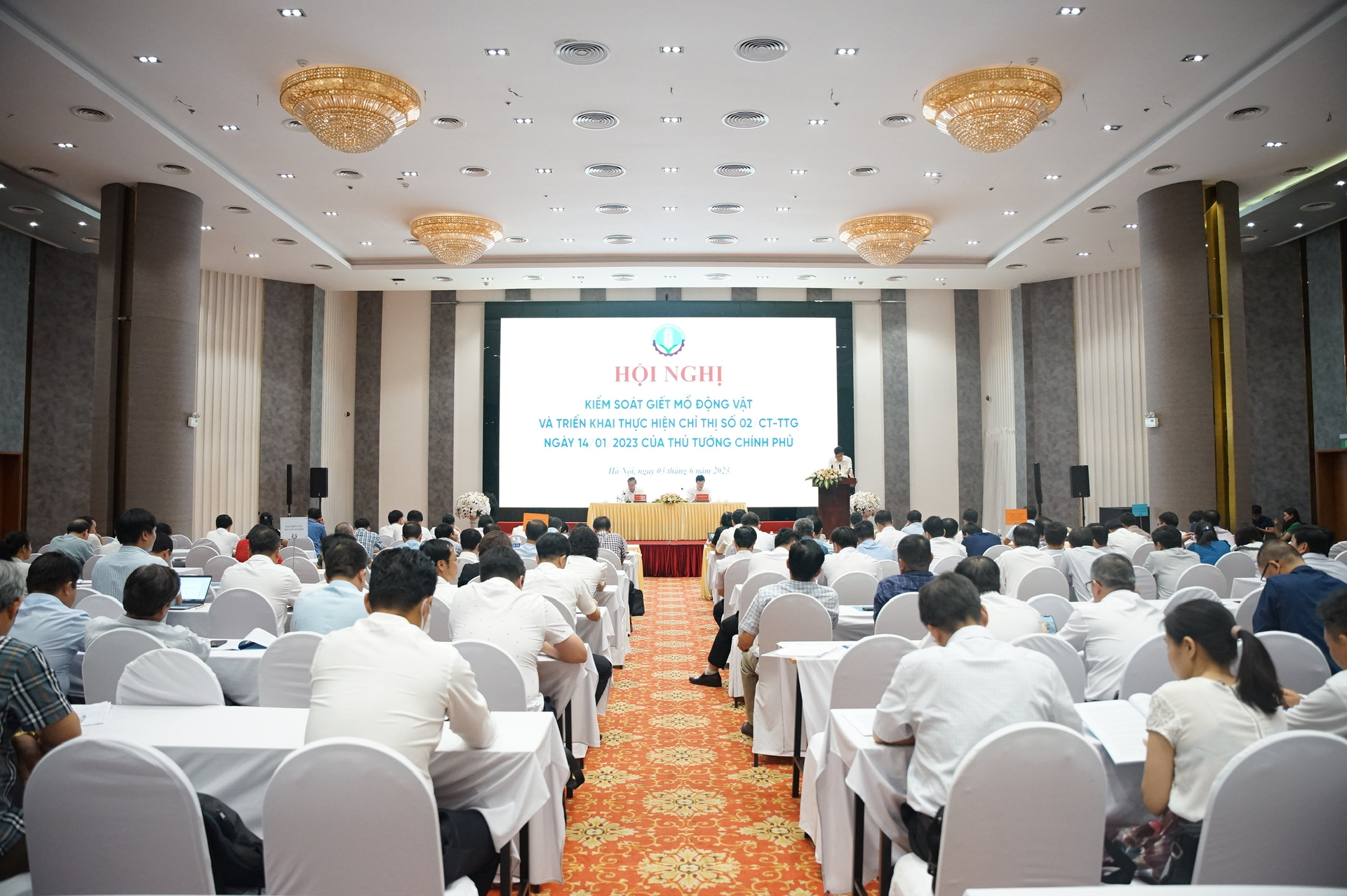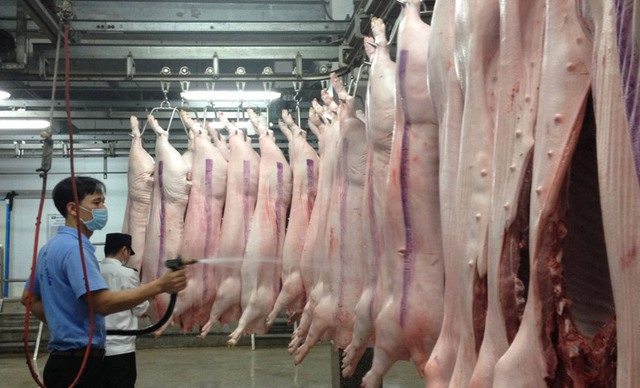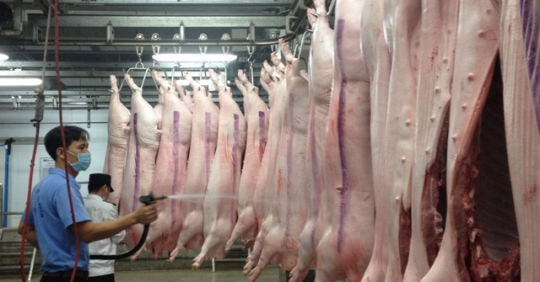
According to the Ministry of Agriculture and Rural Development, there are currently 463 concentrated animal slaughterhouses in the country. Picture: Linh Linh.
On the morning of June 3, the Ministry of Agriculture and Rural Development held a conference on Animal Slaughter Control and Implementation of Prime Minister’s Guideline No. 02/CT-TTg on Strengthening Management and Control of Animal Slaughter, Disease and Food Safety.
Each District requires at least 1 Central Slaughterhouse
Nguyen Thu Thuy, deputy director of the Ministry of Animal Health, said there are currently 463 concentrated animal slaughterhouses across the country with a capacity of over 349,000 cattle, 8.7 million pigs and 78.6 million families, which will be slaughtered in the first five months of 2023 are active.
The industrially concentrated slaughterhouses in particular are well invested by large corporations, companies or joint ventures with other countries.
These farms all slaughter on industrial lines, have modern slaughter, pre-processing and processing processes and cold storage systems to preserve animal products after slaughter in the same production area to ensure veterinary hygiene, food safety and environmental protection.

Deputy Minister Phung Duc Tien chaired the conference on Animal Slaughter Control and Implementation of Prime Minister’s Guideline No. 02/CT-TTg on Strengthening the Administration and Control of Safe Animal Slaughter. diseases, food safety. Picture: Linh Linh.
These industrial chain slaughterhouses require the slaughter of animals of the same size and run the line in large numbers to ensure profitability. Therefore, it is difficult to rent them to small households. animals for slaughter here.
Some plants are still operating at their designed capacity, wasting investment and increasing payback time. Most companies work in the form of a central slaughter on site.
In this model, farms are set up by a number of organizations and individuals with investment capital, but they do not engage in the slaughter and trade in animal products, but are leased to small business households to slaughter animals.
Although this is a notable effort by local authorities to ensure slaughter control, this model has many shortcomings such as: B. the lack of pre-processing lines, meat processing and cold storage for post-mortem preservation.
According to the Department of Animal Health, there are still 24,654 small animal slaughterhouses across the country. Of these, only 7,362 companies have a business registration, the remaining 17,292 (over 70%) have no business registration and are not allowed to be operated by the local authorities.
Many places have more than 1,000 small slaughterhouses such as Nam Dinh, Thanh Hoa, Hai Duong… Although these places are not mountainous provinces, the economic conditions are not difficult, but the control of the slaughter has not changed positively because the local Government hasn’t really paid enough attention.
Meanwhile, some places like Da Nang, Ba Ria-Vung Tau, Binh Phuoc and Can Tho reported no small slaughterhouses.
These are the places where the local authorities show a very active interest and commitment, so the animal slaughter management has changed significantly, estimated Ms. Nguyen Thu Thuy.
Ms Thuy also pointed out the difficulties in asking for investments in animal slaughter, such as B. High investment costs, slow capital recovery, difficult site agreement, complicated land leasing procedures and production costs. size…
In view of the above situation, Ms. Nguyen Thu Thuy suggested establishing mechanisms and policies to encourage enterprises to invest in agriculture and rural areas, which are individuals and organizations when investing capital in the construction of new centralized animal slaughterhouses .
Continue to use preferential tax, credit and land policies to encourage organizations and individuals to invest in building concentrated slaughterhouses.
In addition, the provincial and city people’s committees are required to review and approve the network of concentrated animal slaughterhouses in the province, with each district required to have at least one centralized animal slaughterhouse.
Chain slaughterhouses only operate at 15-30% capacity
Mr. Ta Van Tuong, deputy director of the Ministry of Agriculture and Rural Development in Hanoi, said that there is huge demand for animal products in Hanoi, about 800 to 900 tons a day.
Meanwhile, the total daily amount of cattle and poultry meat from controlled cattle and poultry slaughterhouses in the city reaches over 400 tons/day, and the meat imported to Hanoi is also controlled. The epidemic is around 150 tons/day, which is only 60%. the demand for meat consumed in the Hanoi market controlled from source. The rest is marketed by small and retail slaughterhouses.
There are currently a total of 726 beef and poultry slaughterhouses in the city. Concentrated industrial, semi-industrial and manual slaughterhouses are largely at capacity.
Some farms invest in modern slaughter lines that can only operate at 15-30% of their designed capacity, others have to stop their slaughter activities or switch to ground slaughter (semi-industrial slaughter) to remain active.
Some semi-industrial slaughterhouses are operating effectively, but upon review they have not met the criteria for inclusion in the city’s slaughter network under the Veterinary Medicine Act and the Planning Act.

In Ho Chi Minh City, industrial cattle slaughterhouses are operating at only 50% capacity. Picture: Linh Linh.
“Meanwhile there are still many small slaughterhouses for cattle and poultry, the slaughtering activity is very diverse, the method is mainly manual.
“Most of these slaughterhouses and slaughterhouses do not have a license from local authorities, so the risk of food insecurity is very high,” Tuong said.
A representative of the People’s Committee of Ho Chi Minh City shared the same situation with Hanoi and also said that the city’s industrial cattle slaughterhouses are currently operating at an average of about 50% of their designed capacity. More cattle slaughtering cooperation partners Ensure slaughtering capacity reaches 80-100% depending on orientation.
In addition, the construction and running costs of industrial slaughterhouses are high, but the slaughter prices received by processors are still as cheap as they were before investing in industrial slaughterhouses. Therefore, in the long run, it is easy to create an imbalance between income and expenditure, return capital…, difficult to compete with provincial farms.
In view of this fact, the representative of Hanoi suggested that the Ministry of Agriculture and Rural Development should advise the government to amend Decree 57/2018/ND-CP to support slaughter which is approved by the government and immediately supported . in investments to attract investors.
In addition, it is necessary to establish regulations to classify animal slaughterhouses based on their slaughtering capacity instead of classification according to the current business registration type, in order to be consistent with the decentralization of safety management. Whole food.
To support the operation and development of industrial slaughterhouses and create fair competition with farms, the People’s Committee of Ho Chi Minh City proposed allowing the city to take measures to control meat sources from the provinces. Ho Chi Minh City for business, processing and consumption must come from plants with concentrated animal slaughter, ensuring veterinary hygiene and food safety requirements, and disinfection according to regulations
Deputy Minister of Agriculture and Rural Development Phung Duc Tien reiterated that slaughter system control plays an important role in disease control and food safety in the animal products value chain. In addition, animal welfare controls in slaughterhouses are also an important basis for the export of animal products.
The deputy minister also stressed that provinces and cities need to focus on mechanisms and policies to attract investors to slaughterhouses. Municipalities need to increase budgets for administration, especially for the veterinary system at all levels, with a focus on managing and supervising 100% of the slaughterhouses.
The deputy minister called on the Ministry of Animal Health to increase the training and retraining of veterinary staff at the grassroots level, ensure good communication and improve control of slaughterhouses to combat the risks of food insecurity on farms. At the same time, international cooperation with international organizations is carried out so that Vietnam has good conditions for managing slaughterhouses and ensuring food and disease safety.

